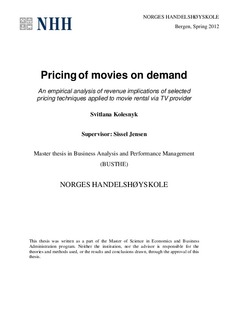Pricing on movies on demand ; an empirical analysis of revenue implications of selected pricing techniques applied to movie rental via TV provider
Master thesis
Permanent lenke
http://hdl.handle.net/11250/169673Utgivelsesdato
2012Metadata
Vis full innførselSamlinger
- Master Thesis [4372]
Sammendrag
This empirical study explores revenue implications of different pricing techniques applied to movie rental via TV-provider (movie on demand). The problem statement is:
What is the optimal pricing technique for movies on demand? How much of the area under demand curve can be captured by sophisticated pricing?
The method used is quantitative research based on the data (12 726 individual movie valuations obtained from 479 participants) gathered in the survey conducted among Norwegian customers of a large international provider of TV-services (Canal Digital DTH). The collected data was fitted into a parametric distribution. Thereafter a dataset containing valuation data from 5000 simulated individuals was created. The dataset was used to compare revenue implications of such pricing alternatives as uniform pricing, component pricing, bundling and two-part tariff. The results of the study show that two-part tariff performs best of all the alternatives listed above. It allows producer to capture almost 60% of the area under demand curve. Such pricing techniques as component pricing and various forms of bundling do not raise producer surplus over 43%. In addition, this study discovered that customers have statistically significant different consumption patterns when it comes to movie rental. The consumption patterns differ by age, gender, the age of children in the household.
